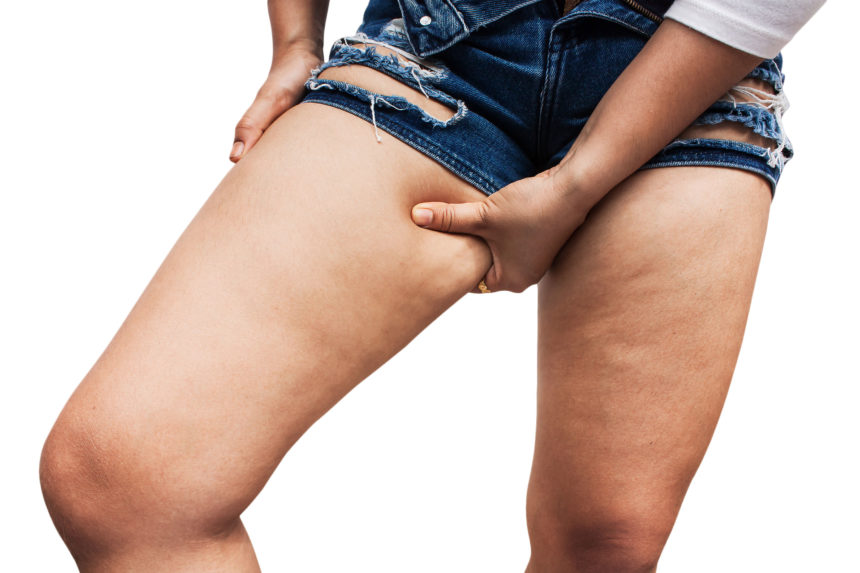Causes of cellulite, let’s get to know it better.
What are the causes of cellulite? What we commonly refer to as cellulite or orange-peel skin, is known by various names, one of which is edematous fibrosclerotic pancicopathy (EFP). This is a blemish caused by an alteration in the hypodermis that is manifested by hypertrophy of the adipose cells. Consequently, the result is the famous accumulation of fat in some areas of the body, most frequently the thighs, hips and buttocks, while in men it appears more in the abdomen.
But what causes cellulite? There are many causes – inflammations, various disorders, genetic or hormonal factors, etc. In short, the list is long and these are just a few. However, we should also consider the aggravating factors that cause cellulite:
- Unhealthy diet
- Sudden weight loss
- Obesity
- Incorrect posture
- Overweight
- Stress
- Sedentary lifestyle
- Other factors
- Fibrous septae
Causes of cellulite: what causes cellulite?
A number of different causes can be highlighted. These causes can be attributed to a combination of factors. Environmental factors and bad habits (such as an unregulated and sodium-rich diet). Generally speaking, the causes of cellulite are therefore multi-factorial.
Causes of cellulite
Theories about the causes of cellulite do not find all in agreement, so we generalise by describing the causes of cellulite as a combination of all factors discussed, including:
- Hormones
- Genetics
- Microcirculation
- Adipose tissue
But it is also believed to be linked to:
- Gender
- Age
- Family history
- Overweight
- Smoking
- Diet
- Stress
- Sedentary lifestyle
- Water intake, essential for eliminating toxins
Causes of cellulite: aggravating factors
Many factors are considered to aggravate cellulite, such as:
- Wrong diet
- Excessively rapid weight loss
- Being overweight or suffering from obesity
- Clothing that is too tight (because it compresses the blood vessels, causing poor circulation)
- Incorrect posture
- Shoes that are too tight or with heels that are too high
- Stress and smoking
- Spending too much time on the feet
- Sedentary lifestyle
Hormonal activity linked to oestrogen.
Oestrogens are therefore classified as among the causes in that they favour fluid retention, creating a defect in the functioning of the microcirculation and, thus, swelling of adipose tissue.
Uncomfortable shoes, tight clothes (trousers that are too tight) can cause circulatory problems because they restrict functioning of both blood and lymphatic circulation, leading to a stagnation of fluids in the subcutaneous tissues. The ideal is to dress in such a way as to ensure comfort and not obstruct the normal flow of blood in the legs and hips.
Subcutaneous adipose tissue is a layer of fat cells under the skin that serves as a reserve of energy.
Even though cellulite is an accumulation of fats, having it does not necessarily mean being overweight. Even thin people can have cellulite. If you are overweight, however, weight loss can help reduce it.
Genetic factors
Genes also play an important role. In fact, it is often the case that one of the causes of cellulite is a genetic predisposition that can lead to hormonal changes and problems with venous circulation.
If other women in your family have cellulite, there is a good chance that you will also be predisposed.
Other causes include:
- Metabolic disorders
- Nutritional disorders
- Sedentary lifestyle
- Smoking (makes the skin dry and causes fluids to stagnate)
Stress (when we are in a state of anxiety, our body begins to produce the hormone cortisol, which can fix fat in the thighs and buttocks) In such cases, solutions include handling stressful situations or avoiding them.
- Contraceptive pill (this was the case with older contraceptive systems that used very high doses of hormones; recently, however, new contraceptive methods with low doses of oestrogens have been developed) In fact, the lower the level of oestrogens, the lower the risk of weight gain and unwanted side effects.
- Structural alterations of connective tissues
- Circulatory system disorders (more frequent in women than in men)
- Alterations in the lymphatic system
- Alterations in the extracellular matrix
- Inflammations (which lead to the acidification of tissues)
- Poor diet
- Dehydration (the body needs at least eight glasses of water per day to maintain its normal functions)
- Total body fat
- Thickness and colour of the skin
- Excessive exposure to sun (the rays facilitate the development of free radicals that weaken connective tissue cells)
- Allergies (when a reaction of intolerance is triggered, the body releases histamine, which can increase fluid retention)
All of the main hypotheses about the possible causes of cellulite are subject to controversy, with arguments for and against, and have led to the idea that “cellulite is multi-factorial”.
Cellulite does not develop directly into the orange peel appearance we see; there are several stages of development stages during which this intensifies. These 4 stages are:
1) Oedematous stage
2) Fibrous stage
3) Soft sclerotic stage
4) Sclerotic stage
Causes of cellulite, are useful for resolving or alleviating this annoying blemish.


